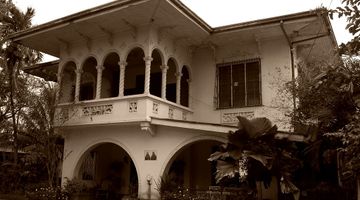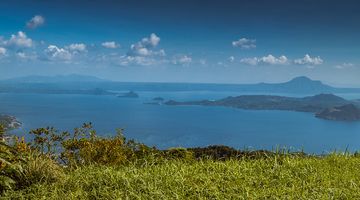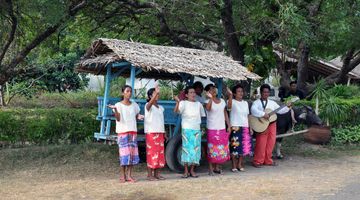Top-10 Tourist Attractions in the Philippines Not to Miss
The Philippines boast several different attractions that travelers of all kinds will appreciate. No matter what it is you’re looking for, you can be sure that the Philippines top tourist attractions will take your breath away. In fact, it’s one of the most picturesque destinations in Southeast Asia so don’t forget to pack your camera.
What to Expect
The rich and colorful history of the Philippines is still very much alive. There are centuries-old churches to explore, tropical white sand beaches, lush forests, interesting museums, spectacular ancient and modern architecture, diverse flora and fauna, various breathtaking landscapes, and jaw-dropping sunsets. These are only a handful of the Philippines attractions places that have captivated the hearts of visitors.
If you’re visiting the Philippines, these are the must see attractions you shouldn’t miss:
1. Banaue Rice Terraces
No top tourist attraction list of the Philippines would be complete without mentioning the Banaue rice terraces, which is a UNESCO World Heritage Site. The rice terraces have been around for over 2,000 years; carved on the hillsides of the remote Cordillera mountain range region. The impressive landscape was built singlehandedly by the Ifugao ethnic tribe who have resided in these mountains since ancient times. One of the most extraordinary features of the Banaue rice terraces is the fact that it’s built at an altitude much higher than other rice terraces found in other parts of the world. Although an ancient attraction, the Banaue rice terraces reflects the intelligence of the Ifugao tribes in creating an advanced irrigation and farming system without using any modern tools – the result is a magnificent natural attraction that has stood the test of time.
2. Bohol Chocolate Hills
The Chocolate Hills are one of the major highlights of Bohol. This iconic landmark obtained its name from the lush vegetation covering 1,268 hills that are almost exactly uniform in size and shape, which turn to a shade of chocolate brown during the dry months of February to July. Until today, nobody knows exactly how the Chocolate Hills were formed. However, most scientists agree that the surreal landscape of the Chocolate Hills are a result of coral deposits, erosion, and saltwater over time. While visiting Bohol, make it a point to see the tarsiers, the world’s smallest primates. Measuring just 4 to 5 inches, the tarsiers can fit in one hand; they possess large eyes and have the ability to rotate its head in each direction to 180 degrees. Bohol’s tarsiers can be seen by visiting the Philippine Tarsier and Wildlife Sanctuary located in Corella, Bohol.
3. Intramuros in Manila
Also known as the Walled City of Manila, Intramuros has a deep historical significance in the Philippines. Intramuros was built during the late 16th century to serve as the seat of the Spanish colonial government with the intention of protecting the city from invaders. Intramuros has served as the background to several historical events including the Battle of Manila, fought between the Japanese Imperial Army and the American soldiers and Filipino guerillas. Today, Intramuros is a reflection of the Spanish influence on Philippine culture with many picturesque cobblestone streets, museums, churches, and charming cafes. Walking around Intramuros will make you feel like you’ve stepped back in time. Visitors can walk around to see the numerous attractions within Intramuros such as Fort Santiago, Plaza Roma, Manila Cathedral, Casa Manila, Silahis Emporium, Baluarte De San Diego, and the San Agustin Church and Museum.
4. Boracay
This tiny island in the Visayas region is number 1 among the top tourist attractions in the Philippines. Boracay has graced the list of numerous international publications, as many travel authorities consider it to be the best beach in the world. There are many stunning beaches in the country, but none can hold a candle to Boracay’s powdery fine white sand, crystal clear turquoise waters, and breathtaking golden sunsets. Aside from its postcard-perfect beaches, Boracay also has many other things to see. These include Willy’s Rock, Mt. Luho, Ariel’s Point, and nearby islands best seen through island-hopping tours. Boats and catamarans can also be rented for a few hours, offering front-row seats to the island’s famed sunsets.
5. Puerto Princesa Subterranean River National Park
Another UNESCO World Heritage Site is the spectacular Puerto Princesa Subterranean River National Park located in Palawan. Some of its distinct features are its karst mountain landscapes and the mountain-to-sea ecosystem, home to some of Asia’s most significant forests. But what makes the river a truly impressive attraction is its 8.2km long underground river system, within which are remarkable rock formations made from stalagmites and stalactites that have developed over hundreds of years. A small boat takes visitors into the massive underground cathedrals, while your friendly boatman’s lamp guides your way through what feels like an otherworldly location. If you’ll be visiting during the summer months, make sure to book your ticket to the Puerto Princesa Subterranean River National Park in advance. Visitors are provided with life jackets and helmets for safe and enjoyable viewing on your boat.
6. Mayon Volcano
Legaspi’s Mayon Volcano is a sight you shouldn’t miss. Considered one of the top 10 tourist attractions in the Philippines, Mayon Volcano is famed for its near-perfect cone shape; it’s no wonder that it appeals so much to photographers and travelers alike. Mayon Volcano is 2,463 meters high, and its beautiful cone shape can be seen from virtually anywhere from Albay. However, the best place to view Mayon Volcano is from Cagsawa Ruins, an ancient location where Cagsawa church is also found – an area that’s also notable and worthy of visiting. Cagsawa church was damaged by the eruption of 1814, known as one of the most destructive eruptions of Mayon volcano. Mayon Volcano is active, with the last recorded eruption occurring just late in January 2018. After seeing Mayon, the nearby Sumlang Lake is also another worthy attraction where visitors can enjoy a relaxing ride aboard a man-made bamboo raft on the calm waters where the volcano serves as the picturesque backdrop.
7. Vigan
Vigan is a history city, a UNESCO World Heritage Site recognized for its well-preserved historical attractions. Vigan was established in the 16th century, and is a prime example of Spanish colonial influences in Asia. The architecture of Vigan is a sight to behold, with hints of European and Chinese influence resulting in a townscape that can’t be found anywhere else in the region. During the colonial era, Vigan served as an important trading post because of its proximity to the Abra river. The town is quaint and peaceful, since most streets in the central area of Vigan prohibit automobiles. Getting around on a horse-drawn carriage is still a common form of transportation in the area, but walking through the streets gives you the feels of being in an old Spanish city. While there, don’t miss the Philippines tourist attractions of Calle Crisologo, the Vigan Cathedral, Syquia Mansion, Plaza Burgos, Crisologo Museum, Bantay Bell Tower, and the Dancing Fountain. There are also several antique shops displaying interesting wares from the Spanish colonial era, which once belonged to the wealthy families who used to reside in Vigan.
8. El Nido
El Nido’s picture-perfect beaches framed by majestic limestone formations is a must-see attraction in the Philippines. Its tropical, pristine beaches have attracted travelers from all over the world who come to experience crystal-clear beaches, emerald green limestone rocks, and unspoiled nature. El Nido’s mesmerizing lagoons are one of this destination’s biggest draws. Up until the last few years, El Nido has remained a secret destination, once known to only a few who were adventurous enough to travel several hours to reach this destination hence its reputation for being the last frontier in the Philippines. Aside from its reputation as a tropical paradise, you can also visit the Cudugnon Cave, which served as a Neolithic burial site. Other notable sites in El Nido include Nacpan Beach, Taraw View Cliffpoint, Marimegmeg Beach, Cadlao Lagoon, and Snake Island. Legend has it that Alex Garland, world-acclaimed novelist of The Beach, was actually in El Nido – the very place that inspired his famous book and the movie that followed.
9. Manjuyod Sandbar
Undeniably one of the top 10 tourist attractions in the Philippines is the Manjuyod sandbar. Given the nickname of “the Maldives of the Philippines”, the Manjuyod sandbar of Dumaguete is a white gem in the middle of the ocean. There’s nothing to be found on the sandbar: no coconut trees, no accommodations, no bathrooms. There are 3 cottages on stilts around the sandbar, but that’s about it. However, the absence of any tourist facilities is actually the best part of Manjuyod sandbar. It’s accessible via an outrigger boat which departs from a port in South Bais Bay, and considering it’s just 15 minutes away, it makes for a great day trip. It’s recommended to visit Manjuyod sandbar during the early morning so that you can enjoy the sandbar in all its beauty during the day. If you’re lucky, you’ll also get to spot dolphins on your way to the sandbar!
10. Batanes
The island province of Batanes has long been on the bucket list of travelers. It was only a few years ago when some airlines began offering flights from Manila to Batanes. The reason why Batanes is such a magical place in the Philippines is because of its seclusion. To this day, Batanes is still remote and considered off-the-beaten-path. Its also the northernmost province in the entire country, although its isolation has done wonders. Batanes is home to the Ivatan tribe who have migrated some 4,000 years ago, and still live there. The prehistoric yet colorful Ivatan culture is very much alive, evident throughout the island especially in the unique limestone houses covered in nipa, which were built to withstand the harsh climate that the province is exposed to. Batanes’ location is right where the China Sea meets the Pacific Ocean, an area that is prone to rough waves and unpredictable weather. For this reason, the ideal time to visit Batanes is between March to June when the rains are minimal and the sun is out most of the time. As half of the main island is covered in rolling hills, majestic mountains, and sweeping views, you will be rewarded with some of the most beautiful sights that the Philippines has to offer.
...
As you can see, the Philippines has a wealth of natural and historical wonders that are beckoning you to come visit. Virtually every destination in the Philippines has several surprises waiting in every corner for you to discover. Not only will the must-see attractions of the country be a feast for your eyes, but it’s a treat for all the senses too! Getting around the top tourist spots is easier than ever because of improved infrastructure, an abundance of budget flights to choose from, and easy communication as almost everyone speaks English.
































































